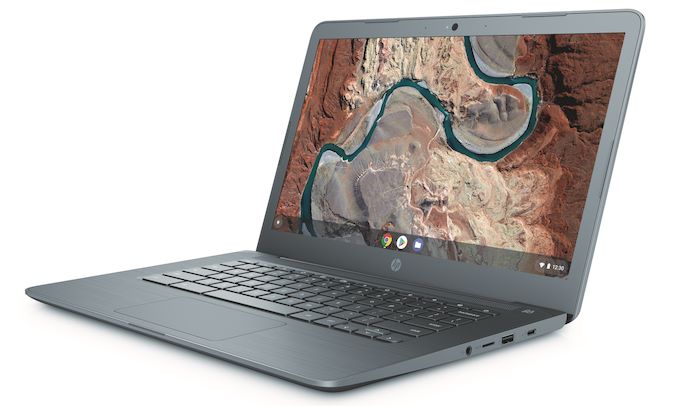HP at CES 2019: HP Chromebook 14 Combines AMD and Chrome OS
by Anton Shilov on January 6, 2019 7:00 PM EST- Posted in
- Laptops
- AMD
- HP
- Chromebook
- CES 2019

When the first Chromebooks were released in 2011, they were aimed at the lower end of the market and carried matching price tags. After Google launched its Pixel laptop in 2013 and proved that it was possible to address the premium segment, other makers of PCs followed on with more advanced Chromebooks that were more expensive. Eventually, Chromebooks somewhat moved away from being exclusively in the low end of the market, and towards a broader market covering multiple price ranges. With the low end market diminished by not forgotten, HP has announced that it's going to take another shot at this segment with its new Chromebook 14. Coincidentally, the Chromebook 14 is also the first ChromeOS-powered PC featuring an AMD processor.
As the name suggests, the HP Chromebook 14 features a 14-inch SVA display panel with a 1366×768 resolution and anti-glare coating. The notebook comes in a fine-looking chassis with a textured finish and a 1.8 cm (0.92-inch) z-height, though HP hasn't specified what kind of material it is made of. Given the thickness, it is reasonable to guess that some sort of a plastic was used (I would assume polycarbonate).
Moving on to the guts of the system. The HP Chromebook 14 is based on AMD’s A4-9120C processor, a relatively unknown SoC featuring two Excavator cores running at 1.8 GHz and the GCN 1.2-based Radeon R4 iGPU with 128 SPs operating at 720 MHz (more information about the SoC is available in Ian’s AMD at CES 2019 coverage). Being fabbed on a 28 nm process and a low-end chip overall, this SoC is cheap enough to that AMD and HP can still turn a profit even with the low-end pricing of the system. All told, do not expect too much from this APU (and therefore the Chromebook 14 as a whole): it can handle productivity apps, VP9/H.264/H.265 decode, play some games, but that is about it.
The Chromebook 14 is equipped 4 GB of DDR4 RAM and 32 GB of local eMMC storage, just like early Chromebooks. As for I/O, it has a Qualcomm 802.11ac Wi-Fi with Bluetooth 4.2 controller, two USB 3.1 Gen 1 Type-C ports, two USB 2.0 Type-A ports, a microSD card reader, a dual microphone array, B&O-badged speakers, a webcam, and so on. Overall, hardware wise the laptop looks pretty much okay.
As for battery life, HP says that its Chromebook 14 lasts for nine hours and 15 minutes on a single charge in their mixed use case workload. The company is using a fairly hefty 47.36 Wh battery here, driven in good part by the need to light up the relatively large 14-inch display.
Finally, while HP is announcing the laptop today, they aren't announcing pricing or an ETA for the device. We may find out more on AMD's Wednesday keynote; competing AMD-powered Chromebooks are due in February, so AMD is just about ready themselves.
Related Reading:
- Google Announces the Pixel Slate: A 12.3-Inch x86-Based Chrome OS Tablet
- Acer’s Chromebox CXI3 Available in Four Configs: Up to Core i7-8550U, Up to $777
- Google Launches Pixelbook: 12.3” LCD, Kaby Lake, 16 GB RAM, 512 GB SSD, Assistant, Stylus
Source: HP










7 Comments
View All Comments
Ashinjuka - Sunday, January 6, 2019 - link
1366×768I like HP EliteBooks a lot but this company should be shamed, ashamed, and punished in the marketplace for continuing to release products at this resolution. It continues to baffle me that anyone working there thinks this is ok.
kirsch - Sunday, January 6, 2019 - link
> After Google launched its Pixel laptop in 2013 and proved that it was possible to address the premium segment.They proved it’s possible to address it, but not that it can be done successfully. Do you have sales numbers for those machines? Have you ever seen any in the wild? Me neither.
zodiacfml - Sunday, January 6, 2019 - link
Like the announced the Acer, I'm fine with the display but not the SoC. It is too old for the given TDP, low perf.nirolf - Monday, January 7, 2019 - link
To HP's credit, they have an alternative for only 30$ more (I dod'nt understand why this is not part of this article):"the new 6W AMD A6-9220C processor, with 2 cores/2 threads, 1.8GHz base clock/2.7GHz boost clock, and Radeon R5 graphics. It has a 1920x1080 touchscreen display."
speculatrix - Sunday, February 3, 2019 - link
Doesn't say if it's VA or S-IPS, so I'm guessing its also TN panel, for maximum ugliness.Brane2 - Sunday, January 6, 2019 - link
Two EXCAVATOR "CORES" ?That's effectively one core end even that looks crappy compared to Zen line cores.
Why do they even bother with that crap ?
Oxford Guy - Sunday, January 6, 2019 - link
Leftover parts? Unused 28nm capacity? Both?